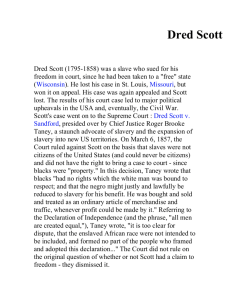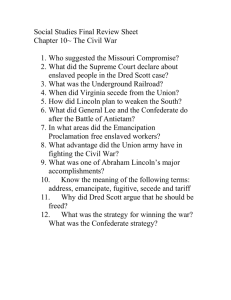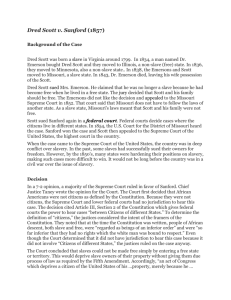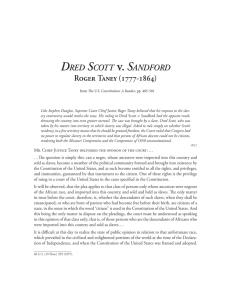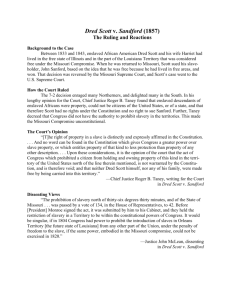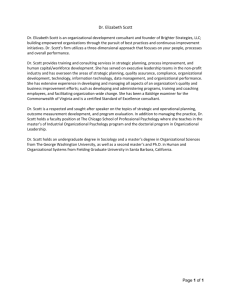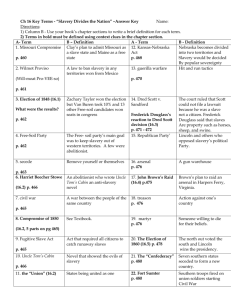Dred Scott v - Ms. Murphy @ Groves High School
advertisement
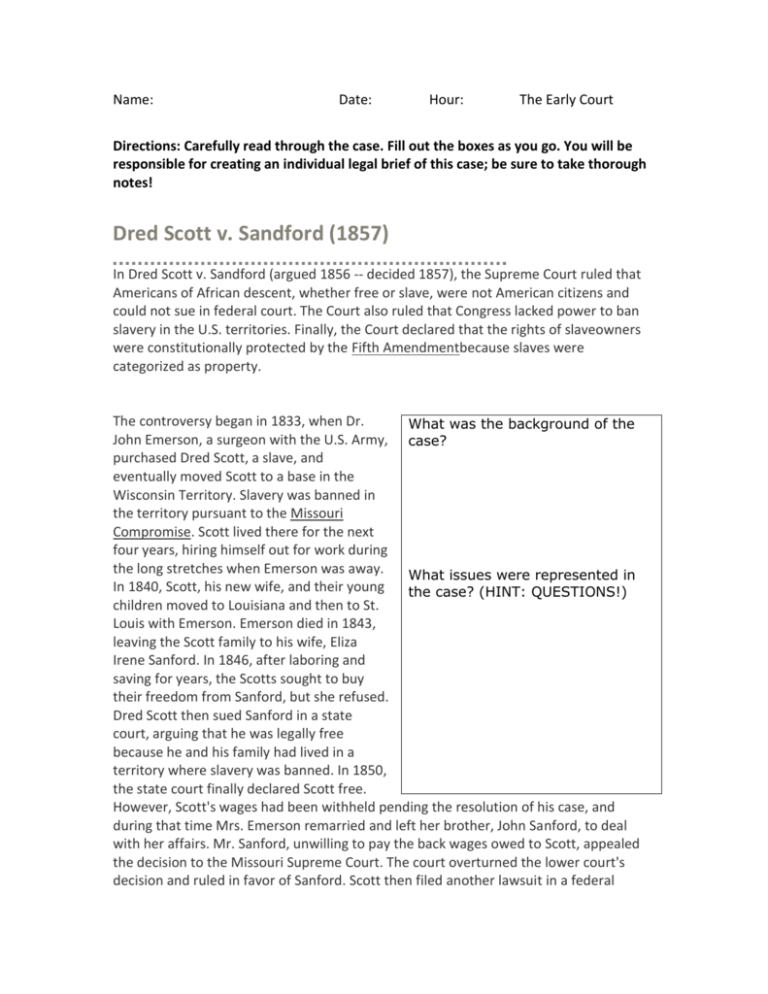
Name: Date: Hour: The Early Court Directions: Carefully read through the case. Fill out the boxes as you go. You will be responsible for creating an individual legal brief of this case; be sure to take thorough notes! Dred Scott v. Sandford (1857) In Dred Scott v. Sandford (argued 1856 -- decided 1857), the Supreme Court ruled that Americans of African descent, whether free or slave, were not American citizens and could not sue in federal court. The Court also ruled that Congress lacked power to ban slavery in the U.S. territories. Finally, the Court declared that the rights of slaveowners were constitutionally protected by the Fifth Amendmentbecause slaves were categorized as property. The controversy began in 1833, when Dr. What was the background of the John Emerson, a surgeon with the U.S. Army, case? purchased Dred Scott, a slave, and eventually moved Scott to a base in the Wisconsin Territory. Slavery was banned in the territory pursuant to the Missouri Compromise. Scott lived there for the next four years, hiring himself out for work during the long stretches when Emerson was away. What issues were represented in In 1840, Scott, his new wife, and their young the case? (HINT: QUESTIONS!) children moved to Louisiana and then to St. Louis with Emerson. Emerson died in 1843, leaving the Scott family to his wife, Eliza Irene Sanford. In 1846, after laboring and saving for years, the Scotts sought to buy their freedom from Sanford, but she refused. Dred Scott then sued Sanford in a state court, arguing that he was legally free because he and his family had lived in a territory where slavery was banned. In 1850, the state court finally declared Scott free. However, Scott's wages had been withheld pending the resolution of his case, and during that time Mrs. Emerson remarried and left her brother, John Sanford, to deal with her affairs. Mr. Sanford, unwilling to pay the back wages owed to Scott, appealed the decision to the Missouri Supreme Court. The court overturned the lower court's decision and ruled in favor of Sanford. Scott then filed another lawsuit in a federal circuit court claiming damages against Sanford's brother, John F.A. Sanford, for Sanford's alleged physical abuse against him. The jury ruled that Scott could not sue in federal court because he had already been deemed a slave under Missouri law. Scott appealed to the U.S. Supreme Court, which reviewed the case in 1856. Due to a clerical error at the time, Sanford's name was misspelled in court records. The Supreme Court, in an infamous opinion written by Chief Justice Roger B. Taney, ruled that it lacked jurisdiction to take Scott's case because Scott was, or at least had been, a slave. First, the Court argued that they could not entertain Scott's case because federal courts, including the Supreme How did the Court find? (ANSWERS) Court, are courts of "peculiar and limited jurisdiction" and may only hear cases brought by select parties involving 1. limited claims. For example, under Article III of the U.S. Constitution, federal courts may only hear cases brought by "citizens" of the United States. The Court ruled that because Scott was "a negro, whose 2. ancestors were imported into this country, and sold as slaves," and thus "[not] a member of the political community formed and brought into existence by the Constitution," Scott was not a citizen and had no right to file a 3. lawsuit in federal court. Second, the Court argued that Scott's status as a citizen of a free state did not necessarily give him status as a U.S. Why? citizen. While the states were free to create their own citizenship criteria, and had done so before the Constitution even came into being, the Constitution gives Congress exclusive authority to define national citizenship. Moreover, the Court argued that even if Scott was deemed "free" under the laws of a state, he would still not qualify as an American citizen because he was black. The Court asserted that, in general, U.S. citizens are only those who were members of the "political community" at the time of the Constitution's creation, along with those individuals' heirs, and slaves were not part of this community. Finally, the Court argued that, in any case, Scott could not be defined as free by virtue of his residency in the Wisconsin Territory, because Congress lacked the power to ban slavery in U.S. territories. The Court viewed slaves as "property," and the Fifth Amendment forbids Congress from taking property away from individuals without just compensation. Justice Benjamin Curtis issued a strong dissent. Taney's holding on standing should have decided the case, but he continued in an effort to settle the brewing sectional battle over slavery. He further held that, because the abolition of slavery in the territories was beyond the constitutional power of Congress and deprived slave owners of their property without due process of law, the Missouri Compromise of 1820 (by which Missouri had been admitted to the Union as a slave state and the further expansion of slavery into all federal territories falling north of the southern boundary of Missouri was prohibited) had been unconstitutional. The decision marked only the second time in its history -- and the first since the 1803 case Marbury v. Madison -- that the Court had invoked its power of judicial review to overturn federal legislation. Benjamin Curtis, a Massachusetts Whig who as a former state legislator had defended the Fugitive Slave Act on constitutional grounds -- and whose confirmation to the Court had been briefly held up by abolitionist opposition in the Senate -- found himself in the unlikely role of dissenter. Curtis' dissent was lengthy, offering a point-by-point rebuttal to each of Taney's assertions; it was also angry, although not out of any abolitionist zeal but rather due to his belief that Taney had used the Court to advance a distinctly political agenda. Curtis did not contest the basic distinction Taney had made between state and national citizenship. However, he held that the road to national citizenship was through state citizenship: any person deemed by any state to be its citizen was also, by definition, a citizen of the United States. In this way, a constitutional path to U.S. citizenship lay open to blacks. What were the main points of Curtis’ dissent? 1. 2. 3. Why? Curtis conducted an extensive historical review of statutes, case law, and demographic records and asserted that in five of the original 13 states, blacks had held citizenship at the time of the Constitution's ratification -- and that they had therefore voted and participated in the process of its ratification. It was "not true, in point of fact, that the Constitution was made exclusively by the white race," he wrote. Therefore, blacks were "in every sense part of the people of the United States [as] they were among those for whom and whose posterity the Constitution was ordained and established." Significantly, however, although Curtis saw the Constitution as providing for the possibility of black citizenship, he stopped far short of endorsing full political equality for blacks -- and, in fact, would later oppose the full extension of the rights of national citizenship to blacks offered by the Fourteenth Amendment. The decision in Dred Scott v. Sandford exacerbated rising sectional tensions between the North and South. Although the Missouri Compromise had already been repealed prior to the case, the decision nonetheless appeared to validate the Southern version of national power, and to embolden proslavery Southerners to expand slavery to all reaches of the nation. Unsurprisingly, antislavery forces were outraged by the decision, empowering the newly formed Republican Party and helping fuel violence between slave-owners and abolitionists on the frontier. Following the Civil War, the Reconstruction Congress passed, and the states ratified, the Thirteenth, Fourteenth, and Fifteenth Amendments, all of which directly overturned the Dred Scott decision. Today, all people born or naturalized in the United States are American citizens who may bring suit in federal court. How did the Dred Scott decision increase sectional tensions leading up to the Civil War? How did the post Civil War Amendments (13-15) connect to the Dred Scott Case? Taken from http://www.pbs.org/wnet/supremecourt/antebellum/landmark_dred.html Checking for Understanding Compare your notes with a partner. Be sure to focus on the background, key issues/ questions, and the court’s response. Using information from you conversation and your knowledge of previous cases, answer questions 1 & 2. 1. How did previous cases like the Amistad and Prigg v. Pennsylvania play into this case? 2. How does Dred Scott impact the Union? Court Cases Ms. Murphy ___________v.___________ Brief Major Court Cases ________________________________________________________ Name of Case: __________________v. _________________________ Date of Case:________ Court: U.S. Supreme Court Parties to the case: 1) Plaintiff-____________________________ 2) Defendant- __________________________ Facts of the Case: ________________________________________________________________________ ________________________________________________________________________ ________________________________________________________________________ ________________________________________________________________________ ________________________________________________________________________ ________________________________________________________________________ Issue(s): ________________________________________________________________________ ________________________________________________________________________ Decision of the courts: _______________________________________________________________________________ _______________________________________________________________________________ Reason for the decision: _______________________________________________________________________________ _______________________________________________________________________________ _______________________________________________________________________________


